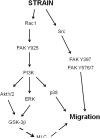The effects of mechanical forces on intestinal physiology and pathology
- PMID: 19249356
- PMCID: PMC2715958
- DOI: 10.1016/j.cellsig.2009.02.011
The effects of mechanical forces on intestinal physiology and pathology
Abstract
The epithelial and non-epithelial cells of the intestinal wall experience a myriad of physical forces including strain, shear, and villous motility during normal gut function. Pathologic conditions alter these forces, leading to changes in the biology of these cells. The responses of intestinal epithelial cells to forces vary with both the applied force and the extracellular matrix proteins with which the cells interact, with differing effects on proliferation, differentiation, and motility, and the regulation of these effects involves similar but distinctly different signal transduction mechanisms. Although normal epithelial cells respond to mechanical forces, malignant gastrointestinal epithelial cells also respond to forces, most notably by increased cell adhesion, a critical step in tumor metastasis. This review will focus on the phenomenon of mechanical forces influencing cell biology and the mechanisms by which the gut responds these forces in both the normal as well as pathophysiologic states when forces are altered. Although more is known about epithelial responses to force, information regarding mechanosensitivity of vascular, neural, and endocrine cells within the gut wall will also be discussed, as will, the mechanism by which forces can regulate epithelial tumor cell adhesion.
Figures



References
Publication types
MeSH terms
Substances
Grants and funding
LinkOut - more resources
Full Text Sources
Other Literature Sources

